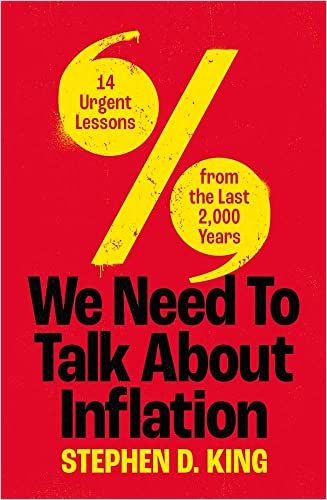Economist Stephen D. King — prolific author, senior economic adviser at HSBC, and columnist for the Evening Standard — details the historical and political causes for recurring inflationary cycles.

Up and Down
Economist Stephen D. King — prolific author, senior economic adviser at HSBC, and columnist for the Evening Standard — reports that, for decades, central bankers and economists had all but forgotten about inflation, fearing deflationary spirals more than rising prices. US inflation topped 9% in 2022 but dropped to 3.2% by July 2023, just after this book’s publication.
Trust, Confidence, and Money Supply
For a decades-long period beginning in the late 1980s, the world enjoyed price stability. That changed during the COVID-19 pandemic: In 2021, prices rose at a startling pace. Central bankers brushed off initial signs of inflation as temporary.
Inflation may sometimes be dormant, but it has never been banished.
Stephen D. King
But inflation accelerated, exacerbated by lockdowns and economic stimulus policies. Stimulus programs filled consumer bank accounts, leading to a surge in spending, even as the pandemic crippled global supply chains.
Runaway prices threaten political stability. Over the past 100 years, hyperinflation generally grew out of policymakers’ desire to keep unemployment in check. They sought to create jobs, not to contain inflation.
Throughout history, steep inflation sprang from reckless monetary policies. In revolutionary France, for example, prices soared nearly 27,000% from early 1790 to early 1796. A scarcity of precious metals triggered the crisis. Those with gold hoarded it or smuggled it abroad. That prevented the minting of coins. The government responded with paper money ostensibly tied to the value of gold or to land expropriated from the Catholic Church. A cash shortage continued, squeezing the poor. Then came counterfeiting: The ensuing flood of cash raised prices, which led to more stockpiling of coins and precious metals. Merchants hoarded, too, reasoning that their inventory would be worth more tomorrow, while paper money would be worth less.
Brazil experimented with sustained inflation from 1950 to 1970.During that period, wholesale prices expanded at a pace of 30% per year. The Brazilian cruzeiro, launched in 1942, was so devalued that it gave way in 1967 to the cruzeiro novo, worth just one one-thousandth of the original currency. Brazil’s dysfunctional monetary policy stayed afloat because the country seemed prosperous — the economy posted a 6% annual growth rate for decades.
Brazil is, admittedly, an extreme example of inflationary excess. Yet there are lessons to be learnt.Stephen D. King
In truth, the inflationary environment skewed the economy. Because real interest rates were negative, Brazilian companies had an incentive to borrow and then invest in capital programs that wouldn’t have made sense in a noninflationary environment. The wealthiest Brazilians were the biggest beneficiaries of inflation, which led to widening income inequality. As of the early 1970s, it seemed that Brazil had managed to prove that an inflationary economy could thrive. Then came the 1980s, which brought annual inflation of 300%, and the 1990s, which saw annual inflation of 200%.
Modern Monetary Theory (MMT)
MMT argues that governments can crank up their printing presses without consequence. While consumers are mere users of money and therefore can’t afford to run out, governments issue currency and can run deficits if they choose. MMT holds that elected officials should have control of economic management, and that unelected central bankers are unaccountable for their mistakes and therefore should cede power to politicians. At its most basic level, MMT espouses an assertive use of the printing press; that sets the stage for further inflation.
As the United Kingdom’s inflation neared 25% in 1975, for example, the government reverted to wage controls. Inflation didn’t respond, and workers, chafing under rising costs of living, rebelled against wage limits. By the mid-1970s, the United Kingdom’s top income tax rate on income had jumped from 75% to 83%, and the government levied a 15% tax on investments. The wealthy took their money out of the country — Sean Connery, Roger Moore, David Bowie, and Rod Stewart went into tax exile.
Pandemic Inflation
Before the pandemic, one measure of the US money supply was growing at less than 7%; by February 2022, that had exploded to 27%. Huge sums gushed into the economy, and consumers couldn’t spend them because of lockdowns.
If the root cause of persistent inflation is inappropriately loose monetary conditions, then no level of subsidies is going to solve the problem.
Stephen D. King
Because inflation had not been a factor in the decades before the pandemic, central bankers refused to acknowledge that inflation could return, no matter how much stimulus they added to the economy. This was denying the obvious — the monetary drivers of inflation were present, yet no one was willing to admit that reality. In recent decades, global trade has allowed producers to cross borders to produce goods at the lowest possible cost, which contains prices. When the pandemic hit, the disinflationary tailwind of efficient global supply chains turned into an inflationary headwind.
Monetary policy often sets the stage for bouts of inflation. Consumers’ trust and actions are as important as lawmakers’ policies. Inflation is good for debtors, and governments issue massive amounts of debt. After the 2008 global financial crisis, governments decided that the only real threat was deflation.
Rising prices create public mistrust. The best policy is to target the root causes of inflation. Hyperinflation creates a crisis that leaders must deal with; modest inflation leads politicians to wonder if the cure is worse than the disease. “Fiscal dominance” was the policy of royals who debased their currencies to wage wars. “Monetary dominance” — the gold standard, for example — constrains government borrowing.
Don’t Expect A Cure
Stephen D. King does not write only for economists nor only for those making a living from the economy; students, investors, and politicians can learn much from his straightforward, detailed history of how political and consumer actions spur inflation. Amusingly, King posits inflation as an almost biological malady, one that throughout history has resisted government efforts to control. Indeed, King blames government policy for the most destructive inflationary cycles. Given his profound expertise, King’s convincing arguments that inflation comes and goes and usually proves resistant to solutions is somewhat disheartening. Nonetheless, this is a lively, informative read.








